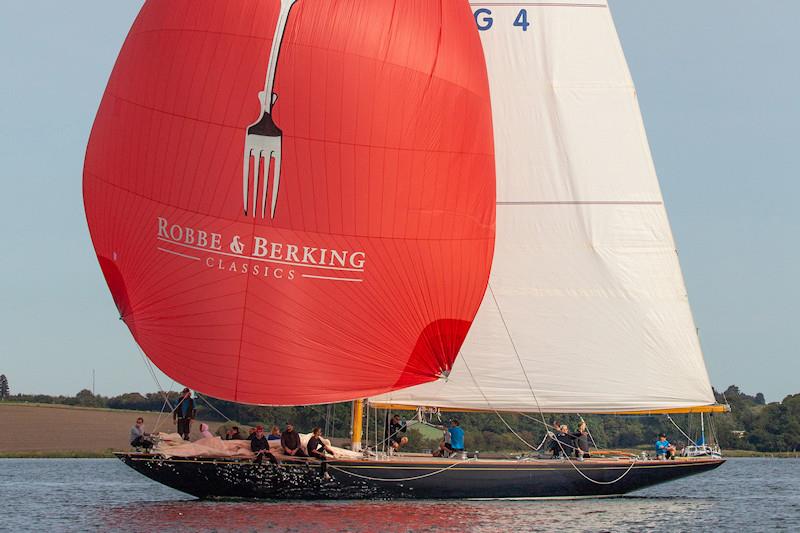
Back to the Future: Classics Embrace Next-Generation Wireless Load Sensing Technology
by Cyclops Marine 9 Aug 2023 09:00 BST

12m Sphinx © Ingvild Buchholz
Many people think of the classic yachting classes as the purists of our sport, and they would be right. But they are, of course, still highly competitive, and the love of traditional designs and materials does not exclude them from innovating to make their vessels excel, with the help of some cutting edge modern technology.
After all, the 12 Metre class for example, has been synonymous with innovation over the years. Breakthroughs in design and construction made by the likes of 'Australia II' will have a legacy that will shape the essence of sailing forever.
Founded 62 years after the 12 Metre was sailed in the America's Cup for the first time, innovator in wireless load sensing, Cyclops Marine has changed the game in competitive sailing. Load sensing is nothing new, but the leaps forward that Cyclops have made, constructing totally wireless sensors for all kinds of applications across yachts, accurate to within 1%, with long-term, reliable calibration, have meant that they have been adopted by everyone from the most prolific Olympians, to the leading IMOCAs, to the current America's Cup teams optimising their AC75s.
Cyclops sensors empower sailors to hit fast, repeatable settings, by providing live loads via your onboard displays and logged load data through a mobile app for post-sail analysis. They are not just hardware upgrades, they are pieces of technology that help you get better as a sailor, squeezing every ounce of performance out of your yacht. They also play a key role in helping sailors protect their rigs by staying safely within loading limits.
It should come as no surprise then, that lovers of classic designs are embracing technology that helps them sail their beautiful yachts exactly as their design intended - and as safely as possible - with a close eye on rig loading allowing them to avoid any accidents and giving them ultimate peace of mind.
12 Metre 'Nini Anker'
Originally designed in 1939 by renowned designer and two-time Olympic gold medalist Johan Anker. Due to illness and war, Design 434 (as it was first known) was never built. However, in 2013, a moment of yachting history saw the first wooden-made 12m yacht in over 50 years built, as she was resurrected from old designs almost a century after conception.
Nini Anker uses smartlink sensors from Cyclops.
12 Metre 'Sphinx'
Another smartlink user, the German-built 12m embarked on its maiden voyage in 1939 with Olympic aspirations, though was hamstrung by a broken mast and restrictions on German sailors in the aftermath of World War II. Sphinx was revitalised under private ownership and racing again in 2008.
The crew of Sphinx have eagerly embraced the introduction of smartlink:
"smartlink has caused great amazement! We always knew that the backstays are the gas pedal of 12 m yachts, but we never had the exact value and therefore had to rely mainly on our feeling."
"We were able to repeat our trim again and again for the first time and found something else, by the way! Every time we put on our mainsheet we lost almost 500 kilos on the backstays."
"For us it means that the load sensors have given us so much new information about our Sphinx that we can use to get faster and faster."
Cetewayo
Named after the Zulu king, Cetewayo was sailed illegally from her mooring and found a hollow abandoned hull, rotting in Pembroke Dock. Restored to her former glory over 15-years, she won the Cowes Classic in 1993 and improvements throughout the 90s saw her claim the 1998 Hamble Winter series before being retired from hard racing in 2001. However, in 2015, true to her Zulu spirit, she rose again, fitted with a brand-new rig, and is still racing successfully.
Cetewayo utilises smarttune from Cyclops on the forestay, giving the crew accurate readings of forestay sag and an overall picture of the dynamic balance of the rig.
Dorade
The prolific S&S-designed Dorade, winner of multiple offshore classics like the Fastnet, the Transatlantic Race and the Transpac, was launched for her 94th season of racing in 2023.
Dorade utilises a combination of smarttune and smartluff, manufactured exclusively for North Sails by Cyclops Marine.
Installed as an upgrade to the tack fitting on your sail, smartluff empowers sailors to hit optimal sail/cable load sharing settings, and when combined with smarttune delivers even better all-round performance data.
8m Hispania IV
Built in 1927 and restored by owner Tanneguy Raffray, the crew of Hispania have found that forestay load has a huge impact on their overall performance:
"On this boat it becomes really important to monitor the forestay loading to ensure that there is always enough tension. In light winds the boat can be sailed with no forestay tension but if we can ensure that the forestay is always loaded that can mean an increase of 0.5 knots boat speed." - Erwan, Hispania IV crew-member
Wave Train
A spring chicken compared to some of the other names in this list, as you can see, the 1987 Julian Everitt-designed Wavetrain has been adapted with carbon bowsprit and a smarttune sensor from Cyclops on the forestay.
These magnificent yachts are finding the perfect blend of old and the new, as they integrate the latest technology from Cyclops Marine to reach optimal performance, protect their beloved rigs, and enhance their sailing experience.
Cyclops is proud to play a role in helping these classics continue to perform at their very best!
Learn more about Cyclops or find the sensor for your yacht.